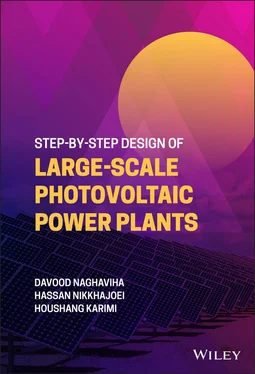Houshang Karimi - Step-by-Step Design of Large-Scale Photovoltaic Power Plants
Здесь есть возможность читать онлайн «Houshang Karimi - Step-by-Step Design of Large-Scale Photovoltaic Power Plants» — ознакомительный отрывок электронной книги совершенно бесплатно, а после прочтения отрывка купить полную версию. В некоторых случаях можно слушать аудио, скачать через торрент в формате fb2 и присутствует краткое содержание. Жанр: unrecognised, на английском языке. Описание произведения, (предисловие) а так же отзывы посетителей доступны на портале библиотеки ЛибКат.
- Название:Step-by-Step Design of Large-Scale Photovoltaic Power Plants
- Автор:
- Жанр:
- Год:неизвестен
- ISBN:нет данных
- Рейтинг книги:3 / 5. Голосов: 1
-
Избранное:Добавить в избранное
- Отзывы:
-
Ваша оценка:
- 60
- 1
- 2
- 3
- 4
- 5
Step-by-Step Design of Large-Scale Photovoltaic Power Plants: краткое содержание, описание и аннотация
Предлагаем к чтению аннотацию, описание, краткое содержание или предисловие (зависит от того, что написал сам автор книги «Step-by-Step Design of Large-Scale Photovoltaic Power Plants»). Если вы не нашли необходимую информацию о книге — напишите в комментариях, мы постараемся отыскать её.
Step-by-Step Design of Large-Scale Photovoltaic Power Plants,
Step-by-Step Design of Large-Scale Photovoltaic Power Plants
Step-by-Step Design of Large-Scale Photovoltaic Power Plants
Step-by-Step Design of Large-Scale Photovoltaic Power Plants — читать онлайн ознакомительный отрывок
Ниже представлен текст книги, разбитый по страницам. Система сохранения места последней прочитанной страницы, позволяет с удобством читать онлайн бесплатно книгу «Step-by-Step Design of Large-Scale Photovoltaic Power Plants», без необходимости каждый раз заново искать на чём Вы остановились. Поставьте закладку, и сможете в любой момент перейти на страницу, на которой закончили чтение.
Интервал:
Закладка:
Symbols
A Land area of a power plantWP Total output power η M Solar module efficiencyG Solar irradianceL F Land factorNPV Difference between present values of the input and the outputB n Benefit at year nN Project life (year)c n Cost at year ni Discount or interest rateIRR Average annual rate of return of a PV plantI Discount or interest ratec Initial investmentBEP Break‐Even PointF Total fixed costsV Variable costs per unit of power productionS Savings or additional returns per unit of power productionI sc Short‐circuit current at the measurement pointI max Maximum amount of the fundamental current componentr Sun–earth distancer Average annual distanceH Irradiation from global radiation on the horizontal planeH D Irradiation from diffuse radiation on the horizontal planek B Shading correction factor as described (non‐shaded: kB = 1)R B Direct beam irradiation factorR D Diffuse radiation factor α 1 Horizon elevation in the γ direction α 2 Facade/roof edge elevation relative to the solar generator plane β Inclination angle of the surface relative to the horizontal plane ρ Reflection factor of the ground in front of the solar generator δ Declination angle φ Latitude ω Hour angle θ Angle of incidenceL ST Standard meridian for the local time zoneL Ioc Location longitudeTE Timen Day number θ Z Zenith angleε Sky clearness indexΔSky brightness indexI b, n DNIm Air massI E Extraterrestrial irradianceI b Beam irradiance on a horizontal surfaceR b Ratio of the beam radiation on the tilted surfaceI d, tilt DHI ρ g Ground reflectance γ Solar azimuth α Solar altitudeD Shading distanceL Length of PV array  Projective length of solar raysK Weight of PV array ϕ Latitude of the locationModuleV mp, min Minimum module voltage expected at the highest site temperatureV mp Rated module voltage at max powerT max Temperature coefficient at maximum expected temperatureΔT Temperature variance between standard test condition (STC) and maximum expected temperatureN s, min Minimum number of PV modules in seriesInverterV min Inverter minimum MPPT voltageModuleV OC, max Maximum module voltage corrected for the lowest ambient temperatureV OC Rated open‐circuit voltage of the PV moduleT min Temperature coefficient at minimum expected temperatureN S, max Maximum number of PV modules in seriesInverterV max Inverter maximum allowable voltageModuleI DC, max Maximum string currentI DC Short‐circuit current of the PV moduleT max Temperature coefficient at maximum expected temperatureP PV, nom Rated PV installed powerG Th A nominal irradiance levelNPR Inverter downsize coefficient (nominal power ratio)P inv, nom − total Total power of the inverter that is required for the entire power plantP inv, nom − exp ected Expected power of the inverterS AC AC active power η Inverter efficiencyS F Safety coefficient and is generally considered between 1.2 and 1.3I O Cable current carrying capacity from datasheetI O, NEW Current carrying capacity corresponding to the installation conditionsT F Correction factor used for ambient temperatureG F Reduction factor used for more than one circuitR Cable resistance per meter.N mod ule Number of modules connected in series to a stringP n Total Pm, STC (nominal power PV module at STC) of modules connected in series (w)V ID Reverse voltage of string diodeV OC, STC Maximum operating open‐circuit voltage of the stringN string Number of PV modules in stringI sc, STC Short‐circuit currentk T Ambient temperature coefficient from datasheetk L Alternating load factor that is normally considered as 0.9k H Derating factor for high number of adjacent fusesI FD Fuse rated current given in the datasheetI DC, max Isc at maximum ambient temperaturek Ir Maximum irradianceI SC, MOD Short‐circuit current of the PV moduleT max normal Maximum permitted average temperature under normal conditions (35 °C)
Projective length of solar raysK Weight of PV array ϕ Latitude of the locationModuleV mp, min Minimum module voltage expected at the highest site temperatureV mp Rated module voltage at max powerT max Temperature coefficient at maximum expected temperatureΔT Temperature variance between standard test condition (STC) and maximum expected temperatureN s, min Minimum number of PV modules in seriesInverterV min Inverter minimum MPPT voltageModuleV OC, max Maximum module voltage corrected for the lowest ambient temperatureV OC Rated open‐circuit voltage of the PV moduleT min Temperature coefficient at minimum expected temperatureN S, max Maximum number of PV modules in seriesInverterV max Inverter maximum allowable voltageModuleI DC, max Maximum string currentI DC Short‐circuit current of the PV moduleT max Temperature coefficient at maximum expected temperatureP PV, nom Rated PV installed powerG Th A nominal irradiance levelNPR Inverter downsize coefficient (nominal power ratio)P inv, nom − total Total power of the inverter that is required for the entire power plantP inv, nom − exp ected Expected power of the inverterS AC AC active power η Inverter efficiencyS F Safety coefficient and is generally considered between 1.2 and 1.3I O Cable current carrying capacity from datasheetI O, NEW Current carrying capacity corresponding to the installation conditionsT F Correction factor used for ambient temperatureG F Reduction factor used for more than one circuitR Cable resistance per meter.N mod ule Number of modules connected in series to a stringP n Total Pm, STC (nominal power PV module at STC) of modules connected in series (w)V ID Reverse voltage of string diodeV OC, STC Maximum operating open‐circuit voltage of the stringN string Number of PV modules in stringI sc, STC Short‐circuit currentk T Ambient temperature coefficient from datasheetk L Alternating load factor that is normally considered as 0.9k H Derating factor for high number of adjacent fusesI FD Fuse rated current given in the datasheetI DC, max Isc at maximum ambient temperaturek Ir Maximum irradianceI SC, MOD Short‐circuit current of the PV moduleT max normal Maximum permitted average temperature under normal conditions (35 °C)  Maximum allowable temperature rise that is 70 °CT amb Ambient temperature
Maximum allowable temperature rise that is 70 °CT amb Ambient temperature  Total short‐circuit current of the arrayR(x)ReflectanceA(x)Absorptance at the angle xT(x)TransmittanceC A temperature‐independent constantE g Band gap of the material extrapolated to absolute zero temperatureq Elementary chargeP in(q) Output power of the PV set q, which is the dc input power of each inverterA S, I(q) Shaded area of the PV set q, which is caused due to the shading by the front (southern) PV blockP pv (y, d, t, β )Actual output power of each PV module on year/day and at timeP max, STC Maximum output power at the STC conditionsP max(G, T)Maximum output power at a given irradiance G and temperature TP dc (t)Inverter dc instantaneous powerP ac (t)AC powerP loss (t)Power lossesP dc, pu Per unit value of dc powerP i PV module powerP max, i Module maximum powerr dc Resistance of the dc cableV dc dc voltage at the cable terminalsP PV, peak Installed peak power under STCG(t)Global solar irradiance on the PV plane at time tr ac AC cable resistanceI ac, cable Line current rms valueV LL rms value of the line voltageN it Total number of invertersN i Number of inverters that are connected to an individual AC cableP Fe Core lossesP Cu, N Copper losses under the nominal operating power SN of each identical transformerS t (t)Total apparent power loading of the installation at the moment tN tr Number of identical transformersP MPP MPP powerV MPP MPP voltageI MPP MPP currentV string Total voltage of string∆T Temperature variance between STC and minimum expected temperature.I sc Short‐circuit current at STC∆V Percentage of cable voltage dropL Cable length∆P Percentage of DC cable power losst Short‐circuit duration that is 1 second for MVU n Rated fuse voltageI SN Nominal current of a fuseI testing Testing current of a fuseLpv, 1length of each PV moduleLpv, 2width of each PV moduleη1, DCDC cables power loss coefficientPLDCpower‐length productPm–sh (y, d, t, β)output power of each PV module at the maximum power points (MPP)Pm (y, d, t, β)power that is produced by each PV module at the MPPNttotal number of strings in a PV installationPDC (t)available DC power at the time tGSTCsolar irradiance under STCDPa coefficient that accounts for the power reduction due to the temperature rise in cellsΔθ(°C)rise of the cell temperature above 25 °C
Total short‐circuit current of the arrayR(x)ReflectanceA(x)Absorptance at the angle xT(x)TransmittanceC A temperature‐independent constantE g Band gap of the material extrapolated to absolute zero temperatureq Elementary chargeP in(q) Output power of the PV set q, which is the dc input power of each inverterA S, I(q) Shaded area of the PV set q, which is caused due to the shading by the front (southern) PV blockP pv (y, d, t, β )Actual output power of each PV module on year/day and at timeP max, STC Maximum output power at the STC conditionsP max(G, T)Maximum output power at a given irradiance G and temperature TP dc (t)Inverter dc instantaneous powerP ac (t)AC powerP loss (t)Power lossesP dc, pu Per unit value of dc powerP i PV module powerP max, i Module maximum powerr dc Resistance of the dc cableV dc dc voltage at the cable terminalsP PV, peak Installed peak power under STCG(t)Global solar irradiance on the PV plane at time tr ac AC cable resistanceI ac, cable Line current rms valueV LL rms value of the line voltageN it Total number of invertersN i Number of inverters that are connected to an individual AC cableP Fe Core lossesP Cu, N Copper losses under the nominal operating power SN of each identical transformerS t (t)Total apparent power loading of the installation at the moment tN tr Number of identical transformersP MPP MPP powerV MPP MPP voltageI MPP MPP currentV string Total voltage of string∆T Temperature variance between STC and minimum expected temperature.I sc Short‐circuit current at STC∆V Percentage of cable voltage dropL Cable length∆P Percentage of DC cable power losst Short‐circuit duration that is 1 second for MVU n Rated fuse voltageI SN Nominal current of a fuseI testing Testing current of a fuseLpv, 1length of each PV moduleLpv, 2width of each PV moduleη1, DCDC cables power loss coefficientPLDCpower‐length productPm–sh (y, d, t, β)output power of each PV module at the maximum power points (MPP)Pm (y, d, t, β)power that is produced by each PV module at the MPPNttotal number of strings in a PV installationPDC (t)available DC power at the time tGSTCsolar irradiance under STCDPa coefficient that accounts for the power reduction due to the temperature rise in cellsΔθ(°C)rise of the cell temperature above 25 °C
1 Introduction
1.1 Solar Energy
The source of solar energy is the sun. Solar energy can be classified as heat which is generated by electromagnetic waves, and light which is produced by photons. Solar energy is the main source of most of the other forms of energy available on the Earth. The solar energy is directly or indirectly converted into other forms of energy, e.g. electrical energy produced through photovoltaic (PV) technologies.
The most important feature of solar energy is that it is clean and does not harm the environment. In the long run, PV power plants will make a significant contribution to the supply of primary energy in all sectors including domestic, commercial, industrial, and transportation consumers. Moreover, factors such as government support, price of fossil fuels, cost of gas emissions CO 2, and costs of PV plant equipment affect the growth of PV plant installation capacity [1].
Figure 1.1shows the energy conversion cycle. It shows that fossil fuels and the renewable energy sources such as biomass, wind and solar energy originate from the sun. The solar energy is stored in chemical bonds through photosynthesis of plants and produces fossil fuels millions of years later.
This book provides an overview of all aspects of designing a large‐scale PV power plant (LS‐PVPP) for the solar energy professionals and the university researchers. The book particularly focuses on the design of all equipment of a large‐scale PV plant from the basic to advanced parts.
Читать дальшеИнтервал:
Закладка:
Похожие книги на «Step-by-Step Design of Large-Scale Photovoltaic Power Plants»
Представляем Вашему вниманию похожие книги на «Step-by-Step Design of Large-Scale Photovoltaic Power Plants» списком для выбора. Мы отобрали схожую по названию и смыслу литературу в надежде предоставить читателям больше вариантов отыскать новые, интересные, ещё непрочитанные произведения.
Обсуждение, отзывы о книге «Step-by-Step Design of Large-Scale Photovoltaic Power Plants» и просто собственные мнения читателей. Оставьте ваши комментарии, напишите, что Вы думаете о произведении, его смысле или главных героях. Укажите что конкретно понравилось, а что нет, и почему Вы так считаете.












